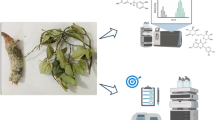Abstract
Berberine, palmatine, and coptisine are major pharmacologically active protoberberine alkaloids in Coptidis Rhizoma, and have been used as indices for chemical evaluation of the crude drug. 1H-NMR spectroscopy was applied to determination of purities of commercial reagents of protoberberine alkaloids. The purities of the alkaloids were calculated from the ratios of the intensities of the H-13 singlet signal at about δ 8.7 ppm of target protoberberine alkaloids to integration of a hexamethyldisilane (HMD) signal at 0 ppm. The concentration of HMD was corrected with SI traceability using potassium hydrogen phthalate of certified reference material (CRM) grade. The purity of the reagent estimated by the 1H-NMR was, in general, lower than that claimed by the manufacturer, leading to over-estimation of the alkaloid contents of Coptidis Rhizoma when determined by HPLC. The present quantitative 1H-NMR method was also applicable to direct determination of protoberberine alkaloid contents in Coptidis Rhizoma.





Similar content being viewed by others
References
Lee CH, Lee HJ, Jeon JH, Lee HS (2005) In vivo antifungal effects of Coptis japonica root-derived isoquinoline alkaloids against phytopathogenic fungi. J Micobiol Biotechnol 15:1402–1407
Tanabe H, Suzuki H, Mizukami H, Inoue M (2005) Double blockade of cell cycle progression by coptisine in vascular smooth muscle cells. Biochem Pharmacol 70:1176–1184
Hu JP, Nishishita K, Sakai E, Yoshida H, Kato Y, Tsukuba T, Okamoto K (2008) Berberine inhibits RANKL-induced osteoclast formation and survival through suppressing the NF-κB and Akt pathways. Eur J Pharmacol 580:70–79
Cui G, Qin X, Zhang Y, Gong Z, Ge B, Zang YQ (2009) Berberine differentially modulates the activities of ERK, p38 MAPK, and JNK to suppress Th17 and Th1 T cell differentiation in type 1 diabetic mice. J Biol Chem 284:28420–28429
Jung HA, Min BS, Yokozawa T, Lee JH, Kim YS, Choi JS (2009) Anti-Alzheimer and antioxidant activities of Coptidis Rhizoma alkaloids. Biol Pharm Bull 32:1433–1438
Ministry of Health, Labour and Welfare of Japan (2006) The Japanese Pharmacopeia, 15th edn. Jiho, Tokyo, pp 1187–1188
Pauli GF, Jaki BU, Lankin DC (2005) Quantitative 1H NMR: development and potential of a method for natural products analysis. J Nat Prod 68:133–149
Hasada K, Yoshida T, Yamazaki T, Sugimoto N, Nishimura T, Nagatsu A, Mizukami H (2010) Quantitative determination of atractylon in Atractylodis Rhizoma and Atractylodis Lanceae Rhizoma by 1H-NMR spectroscopy. J Nat Med 64:161–166
Pauli GF (2001) QNMR—a versatile concept for the validation of natural product reference compounds. Phytochem Anal 12:28–42
Saito T, Ihara T, Koike M, Kinugasa S, Fujimine Y, Nose K, Hira T (2009) A new traceability scheme for the development of international system-traceable persistent organic pollutant reference materials by quantitative nuclear magnetic resonance. Accred Qual Assur 14:79–86
Tahara M, Sugimoto N, Suematsu T, Arifuku K, Saito T, Ihara T, Yoshida Y, Tada A, Kubota R, Shimizu K, Yamazaki T, Tanamoto K, Nakazawa H, Nishimura T (2009) Quality control of organophosphorous isoxathion oxon based on qNMR. Jpn J Food Chem Saf 16:28–33
Sugimoto N, Tada A, Suematsu T, Arifuku K, Saito T, Ihara T, Yoshida Y, Kubota R, Tahara M, Shimizu K, Ito S, Yamazaki T, Kawamura Y, Nishimura T (2010) Absolute quantification of carminic acid in cochineal extract by quantitative NMR. Food Hyg Saf Sci 51:19–27
Ikuta A, Kobayahi A, Itokawa H (1984) Studies on the quantitative analysis of protoberberine alkaloids in Japanese, Chinese and other countries Coptis rhizomes by thin layer chromatograph-densitometry. Shoyakugaku Zasshi 38:279–282
Yoneda K, Yamagata E, Miyaura M, Longjin H, Mizuno M (1987) Quantitative analysis of berberine type alkaloids and Japanese Coptis Rhizoma. Shoyakugaku Zasshi 41:205–208
Kong WJ, Zhao YL, Xiao XH, Jin C, Li ZL (2009) Quantitative and chemical fingerprint analysis for quality control of Rhizoma Coptidischinensis based on UPLC-PAD combined with chemometrics methods. Phytomedicine 16:950–959
Sun SW, Tseng HM (2005) Sensitivity improvement on detection of Coptidis alkaloids by sweeping in capillary electrophoresis. J Pharm Biomed Anal 37:39–45
Chen J, Zhao H, Wang X, Lee FSC, Yang H, Zheng L (2008) Analysis of major alkaloids in Rhizoma coptidis by capillary electrophoresis-electrospray-time of flight mass spectrometry with different background electrolytes. Electrophoresis 29:2135–2147
Li CY, Tsai SI, Damu AG, Wu TS (2009) A rapid and simple determination of protoberberine alkaloids in Rhizoma Coptidis by 1H NMR and its application for quality control of commercial prescriptions. J Pharm Biomed Anal 49:1272–1276
Acknowledgment
This work is supported by Health and Labour Sciences Research Grants from the Ministry of Health, Labour and Welfare of Japan.
Author information
Authors and Affiliations
Corresponding author
Rights and permissions
About this article
Cite this article
Hasada, K., Yoshida, T., Yamazaki, T. et al. Application of 1H-NMR spectroscopy to validation of berberine alkaloid reagents and to chemical evaluation of Coptidis Rhizoma. J Nat Med 65, 262–267 (2011). https://doi.org/10.1007/s11418-010-0490-x
Received:
Accepted:
Published:
Issue Date:
DOI: https://doi.org/10.1007/s11418-010-0490-x




